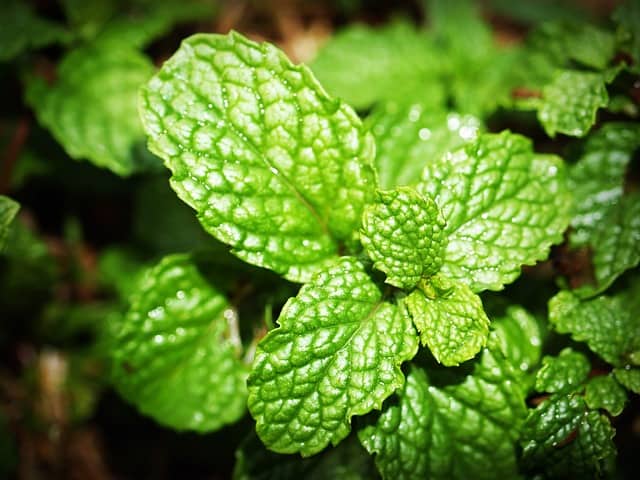Mint is a popular herb that is used in a variety of dishes and drinks for its refreshing taste and aroma. However, brown spots on mint leaves can be a common problem that many gardeners and plant enthusiasts encounter.
These unsightly spots can be caused by a number of factors, including pests, diseases, and environmental conditions.
Identifying the cause of brown spots on mint leaves is crucial to finding an effective solution. Overwatering, underwatering, and exposure to extreme temperatures can all contribute to the development of brown spots. In addition, specific diseases and pests, such as spider mites and aphids, can also cause brown spots on mint leaves.
If left untreated, brown spots can spread and eventually lead to the death of the plant. Fortunately, there are a variety of treatment and control measures that can be used to combat brown spots on mint leaves.
Regular preventive care, such as proper watering and fertilization, can also help prevent the development of brown spots in the first place.
Key Takeaways
- Identifying the cause of brown spots on mint leaves is crucial to finding an effective solution.
- Specific diseases and pests, such as spider mites and aphids, can cause brown spots on mint leaves.
- Regular preventive care, such as proper watering and fertilization, can help prevent the development of brown spots.
More on this category:
Identifying Brown Spots on Mint Leaves
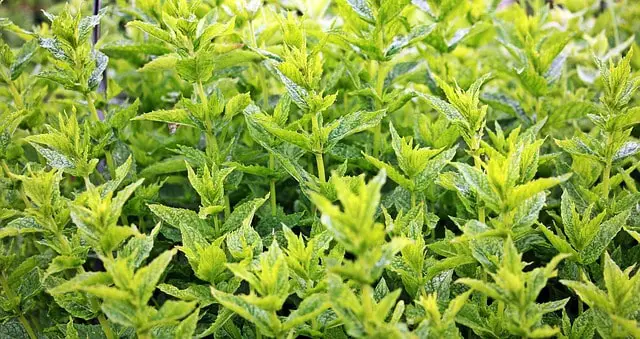
Mint is a popular herb that is used in various dishes, teas, and cocktails. However, it is not uncommon for mint leaves to develop brown spots, which can be a sign of underlying issues. Identifying brown spots on mint leaves can help you take the necessary steps to address the problem and prevent further damage.
Appearance of Brown Spots on Mint Leaves
Brown spots on mint leaves can vary in size and shape. They can appear as small dots or larger patches, and they may be surrounded by a yellow or black ring. In some cases, the brown spots may be accompanied by other symptoms such as leaf loss, curling, or wilting.
Possible Causes of Brown Spots on Mint Leaves
There are several reasons why mint leaves may develop brown spots. Some of the most common causes include:
- Fungal diseases: Mint rust and downy mildew are two fungal diseases that can cause brown spots on mint leaves. Mint rust typically starts as small brown spots that can eventually cover the entire leaf. Downy mildew can cause yellow spots on the leaves that eventually turn brown.
- Overwatering: Overwatering can cause the roots of the mint plant to become waterlogged, which can lead to brown spots on the leaves. The excess moisture can also promote the growth of fungi and bacteria that can damage the plant.
- Underwatering: On the other hand, underwatering can cause the leaves of the mint plant to dry out and turn brown.
- Pests: Pests such as spider mites, aphids, and thrips can cause damage to the leaves of the mint plant, leading to brown spots.
- Nutrient deficiencies: A lack of nutrients such as nitrogen, phosphorus, and potassium can cause the leaves of the mint plant to turn brown.
Mint Leaves Brown Spots – 4 Common Problems
Mint leaves turning brown is a common problem that many gardeners face. Brown spots on the leaves can be caused by a variety of factors, including fungi, pests, and environmental conditions. In this section, we will discuss some of the most common causes of brown spots on mint leaves.
1. Overwatering

Overwatering is a common cause of brown spots on mint leaves. When the soil remains moist for too long, the roots cannot breathe, and the plant cannot absorb nutrients from the soil. This can cause the leaves to turn brown and eventually die.
To prevent overwatering, it is important to ensure that the soil is well-drained and that the plant is not watered too frequently.
2. Fungal Diseases
Fungal diseases such as mint rust (Puccinia menthae) and downy mildew can cause brown spots on mint leaves. Mint rust is a fungal disease that affects the mint family, especially spearmints and peppermints. It starts with small brown spots on the leaves, which eventually turn into yellow pustules.
Downy mildew, on the other hand, starts with yellow spots on the leaves and can cause the leaves to turn brown and fall off the plant. To prevent fungal diseases, it is important to maintain good air circulation around the plant and avoid overhead irrigation.
3. Pests
Pests such as aphids, spider mites, and cutworms can also cause brown spots on mint leaves. Mint aphids, for example, feed on the sap of the plant, which can cause the leaves to turn brown.
Spider mites and cutworms can also damage the leaves and cause brown spots to appear. To prevent pest infestations, it is important to keep the plant healthy and to monitor it regularly for signs of damage.
4. Environmental Conditions
Environmental conditions such as low humidity, direct sunlight, and nutrient deficiencies can also cause brown spots on mint leaves. Low humidity can cause the leaves to dry out and turn brown, while direct sunlight can cause the leaves to burn and turn brown.
Nutrient deficiencies, especially potassium, can also cause brown spots to appear on the leaves. To prevent environmental damage, it is important to provide the plant with the right amount of water, sunlight, and nutrients.
Specific Diseases and Pests
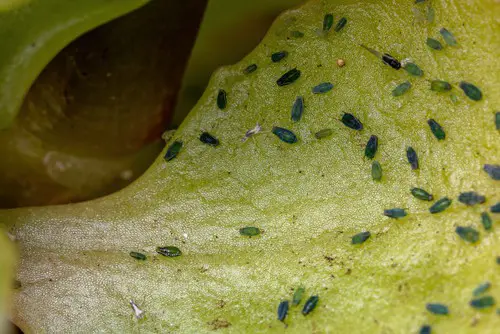
Mint plants are susceptible to various diseases and pests that can cause brown spots on their leaves. Here are some of the most common diseases and pests that affect mint plants:
1. Mint Rust Fungus
Mint rust is a fungal disease that mainly affects the mint family, especially spearmints and peppermints. It starts with small brown spots on the mint leaves, which eventually turn into large, yellowish-brown pustules.
The infected leaves may also become distorted and fall off the plant. Mint rust can be controlled by removing infected leaves and improving air circulation around the plant.
2. Leaf Blight
Leaf blight is a fungal disease that causes brown spots on the leaves of mint plants. The spots may have a yellow halo around them and can merge together to form large patches.
The infected leaves may also become distorted and fall off the plant. Leaf blight can be controlled by removing infected leaves and improving air circulation around the plant.
3. Leaf Spot Disease
Leaf spot disease is a fungal disease that causes brown spots on the leaves of mint plants. The spots may have a yellow halo around them and can merge together to form large patches.
The infected leaves may also become distorted and fall off the plant. Leaf spot disease can be controlled by removing infected leaves and improving air circulation around the plant.
4. Anthracnose
Anthracnose is a fungal disease that causes brown spots on the leaves of mint plants. The spots may have a yellow halo around them and can merge together to form large patches. The infected leaves may also become distorted and fall off the plant.
Anthracnose can be controlled by removing infected leaves and improving air circulation around the plant.
5. Septoria Leaf Spot
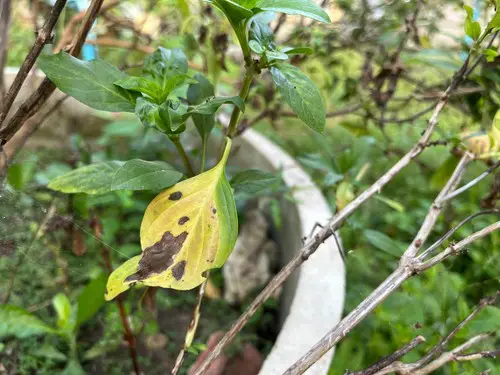
Septoria leaf spot is a fungal disease that causes brown spots on the leaves of mint plants. The spots may have a yellow halo around them and can merge together to form large patches. The infected leaves may also become distorted and fall off the plant.
Septoria leaf spot can be controlled by removing infected leaves and improving air circulation around the plant.
6. Web Blight
Web blight is a fungal disease that causes brown spots on the leaves of mint plants. The spots may have a yellow halo around them and can merge together to form large patches. The infected leaves may also become distorted and fall off the plant.
Web blight can be controlled by removing infected leaves and improving air circulation around the plant.
7. Rhizoctonia Solani
Rhizoctonia solani is a fungal disease that causes brown spots on the leaves of mint plants. The spots may have a yellow halo around them and can merge together to form large patches. The infected leaves may also become distorted and fall off the plant.
Rhizoctonia solani can be controlled by removing infected leaves and improving air circulation around the plant.
8. Verticillium Wilt
Verticillium wilt is a fungal disease that causes brown spots on the leaves of mint plants. The spots may have a yellow halo around them and can merge together to form large patches. The infected leaves may also become distorted and fall off the plant.
Verticillium wilt can be controlled by removing infected leaves and improving air circulation around the plant.
9. Viral Disease
Viral diseases can cause brown spots on the leaves of mint plants. The spots may have a yellow halo around them and can merge together to form large patches. The infected leaves may also become distorted and fall off the plant.
There is no cure for viral diseases, so infected plants should be removed and destroyed to prevent the spread of the virus.
10. Sooty Mold
Sooty mold is a fungal disease that causes black spots on the leaves of mint plants. The spots may have a yellow halo around them and can merge together to form large patches. The infected leaves may also become distorted and fall off the plant.
Sooty mold can be controlled by removing infected leaves and improving air circulation around the plant.
11. Cephalosporium spp
Cephalosporium spp is a fungal disease that causes brown spots on the leaves of mint plants. The spots may have a yellow halo around them and can merge together to form large patches.
The infected leaves may also become distorted and fall off the plant. Cephalosporium spp can be controlled by removing infected leaves and improving air circulation around the plant.
12. Pest Infestation
Pests like aphids, cutworms, or thrips can cause brown spots on mint leaves by sucking the sap from them. Pest infestations can be controlled by removing infected leaves and using insecticides. It is important to identify the pest correctly before using any insecticide, as some insecticides may not be effective against certain pests.
Treatment and Control Measures

When it comes to treating brown spots on mint leaves, there are several control measures that can be taken to help prevent further damage to the plant.
One of the first steps is to prune off any affected leaves or stems. This can help prevent the spread of disease to other parts of the plant. Additionally, improving air circulation and ensuring proper drainage can help prevent moisture buildup and fungal growth.
If the brown spots are caused by a fungal infection, using a fungicide may be necessary. There are several fungicides available that are specifically designed for use on herbs, such as Bonide Copper Fungicide. It is important to carefully follow the instructions on the label when using any type of fungicide.
Insect infestations can also cause brown spots on mint leaves. In this case, using an insecticide or insecticidal soap can help control the pests. Neem oil is a natural insecticide that can be effective against a variety of pests, including aphids and spider mites.
If the brown spots are caused by a nutrient deficiency, repotting or transplanting the plant into fresh soil with proper nutrients can help. It is important to sanitize the plant and its surroundings to prevent the spread of disease.
Preventive Care for Mint Plants
Mint plants are generally easy to grow, but they do require some care to prevent brown spots on their leaves. Proper care can help prevent many of the issues that lead to browning, including overwatering, lack of nutrients, and pest infestations. Here are some preventive care tips for mint plants:
1. Watering
Mint plants require adequate moisture to thrive, but overwatering can lead to root rot and browning of the leaves. The key is to keep the soil moist but not waterlogged.
The frequency of watering will depend on the weather conditions and the size of the pot. Generally, it is recommended to water the plant when the top inch of soil feels dry to the touch.
2. Pots and Soil
Mint plants can be grown in pots or in the ground. If growing in pots, it is essential to choose a well-draining potting mix and a pot with drainage holes. This will prevent water from sitting in the bottom of the pot and causing root rot.
It is also a good idea to repot the plant every year or two to refresh the soil and prevent the roots from becoming too crowded.
3. Sunlight

Mint plants prefer partial shade, but they do need some sunlight to grow. A shady spot with dappled sunlight is ideal. If the plant is getting too much sun, the leaves may turn brown or yellow. If the plant is not getting enough sunlight, it may become leggy and weak.
4. Mulch
Mulching around the base of the plant can help retain moisture in the soil and prevent weeds from growing. Organic mulches like straw, wood chips, and leaves are ideal. Avoid using plastic mulch as it can trap moisture and lead to root rot.
5. Nutrient Ratio
Mint plants require a balanced ratio of nutrients to grow properly. A good rule of thumb is to use a fertilizer with an N-P-K ratio of 3-1-2. This means the fertilizer contains three parts nitrogen, one part phosphorus, and two parts potassium.
However, it is important not to over-fertilize as this can lead to salt buildup and browning of the leaves.
6. Oxygen
Mint plants require oxygen to grow properly. It is important to ensure that the soil is not compacted and that there is adequate airflow around the plant. This can be achieved by loosening the soil around the plant and ensuring that the pot has drainage holes.
7. Shady Spots
Mint plants prefer a shady spot, especially during the hot summer months. If the plant is exposed to too much direct sunlight, the leaves may turn brown or yellow. It is best to place the plant in a spot that receives morning sunlight and afternoon shade.
8. Varieties
There are many varieties of mint plants, including spearmint and peppermint. Some varieties are more prone to browning than others. It is important to choose a variety that is well-suited to the growing conditions and climate in your area.
Remedies and Solutions
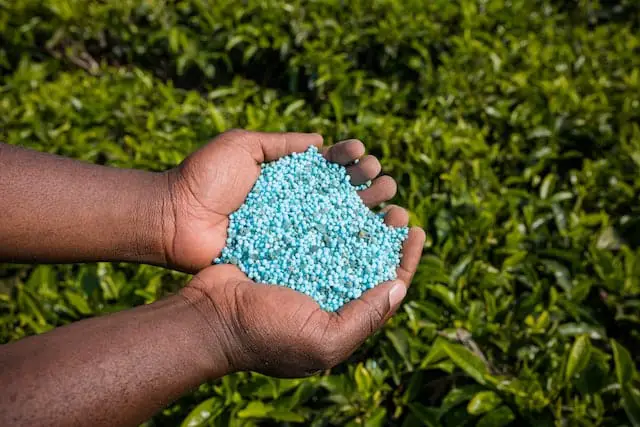
When it comes to treating brown spots on mint leaves, there are a few remedies and solutions that can be implemented. Here are some effective ways to treat infected leaves, prevent leaf drop, and control weed growth:
1. Prune Infected Leaves
The first step in treating brown spots on mint leaves is to remove any infected leaves. Pruning the affected leaves will help prevent the spread of the disease to other parts of the plant.
Use clean, sharp scissors or pruning shears to remove the infected leaves. Be sure to dispose of the infected leaves in a sealed bag to prevent the spread of the disease.
2. Control Weed Growth
Weeds can compete with mint plants for nutrients and water, which can lead to stress and weaken the plant’s immune system. To control weed growth, remove any weeds that are growing near the mint plant. You can also use a layer of organic mulch to prevent weed growth.
3. Adjust Watering Frequency
Overwatering or underwatering can cause brown spots on mint leaves. To prevent this, adjust the watering frequency based on the plant’s needs. Mint plants prefer moist soil, but they don’t like to be waterlogged. To check if the plant needs water, stick your finger in the soil. If it feels dry, it’s time to water the plant.
4. Use Natural Remedies
There are several natural remedies that can help treat brown spots on mint leaves. For example, a mixture of baking soda, vegetable oil, liquid dish soap, and water can be used to control fungal diseases.
Mix 2 tablespoons of baking soda, 4 tablespoons of vegetable oil, 3 teaspoons of liquid dish soap, and 2 gallons of water in a spray bottle. Shake well and spray the solution on the affected leaves.
5. Provide Proper Nutrition
Mint plants need proper nutrition to grow healthy and strong. Use a balanced fertilizer to provide the plant with the necessary nutrients. Be sure to follow the instructions on the fertilizer package and avoid over-fertilizing, which can lead to leaf burn.
By implementing these remedies and solutions, it is possible to treat brown spots on mint leaves and prevent further damage to the plant.
Frequently Asked Questions

How do I treat brown spots on mint leaves?
Treating brown spots on mint leaves depends on the underlying cause. If the cause is a fungal disease like mint rust or downy mildew, then removing the affected leaves and treating the plant with a fungicide can help.
If the cause is overwatering or poor soil drainage, then reducing watering frequency and improving soil drainage can help. If the cause is pest infestation, then using insecticidal soap or neem oil can help.
What causes brown spots on mint leaves?
Brown spots on mint leaves can be caused by a variety of factors, including overwatering, poor soil drainage, fungal diseases like mint rust or downy mildew, pest infestation, salts in the soil, over-fertilization, root overgrowth, and sunburns.
Are brown spots on mint leaves harmful to eat?
Brown spots on mint leaves are not harmful to eat, but they can affect the taste and quality of the mint leaves. It is best to remove the affected leaves and use only the healthy ones for consumption.
What are some natural treatments for mint rust?
Some natural treatments for mint rust include spraying the affected plant with a mixture of baking soda and water, using a solution of chamomile tea and water, or using a mixture of neem oil and water.
How can I prevent brown spots from forming on my mint leaves?
To prevent brown spots from forming on mint leaves, it is important to provide the plant with proper soil drainage, avoid overwatering, use a well-draining potting mix, provide adequate air circulation, and avoid overhead watering.
Keeping the plant healthy and well-fed with proper nutrients can also help prevent brown spots.
Can brown spots on mint leaves be a sign of overwatering?
Yes, brown spots on mint leaves can be a sign of overwatering. Overwatering can cause the soil to become waterlogged and prevent the roots from getting enough oxygen, leading to root rot and brown spots on the leaves.

Hey, I’m Lisa and I’ve been an avid gardener for over 30 years. I love writing, talking and living in the garden! Feel free to connect with me on my socials below

